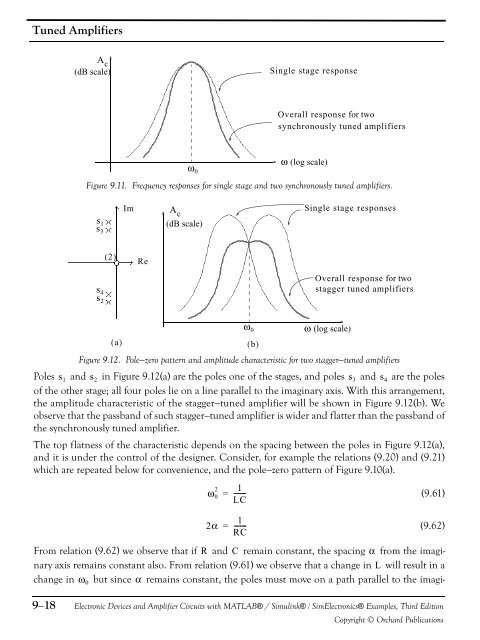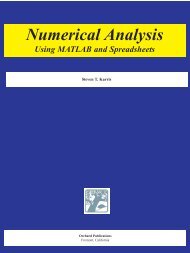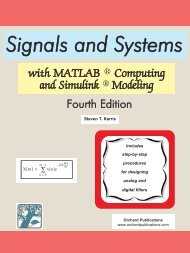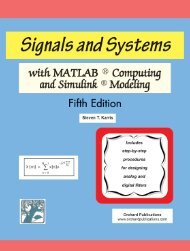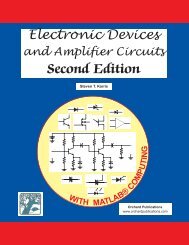Electronic Devices and Amplifier Circuits
Electronic Devices and Amplifier Circuits - Orchard Publications
Electronic Devices and Amplifier Circuits - Orchard Publications
You also want an ePaper? Increase the reach of your titles
YUMPU automatically turns print PDFs into web optimized ePapers that Google loves.
Tuned <strong>Amplifier</strong>sA c(dB scale)Single stage responseOverall response for twosynchronously tuned amplifiersω 0ω (log scale)Figure 9.11. Frequency responses for single stage <strong>and</strong> two synchronously tuned amplifiers.s 1s 3ImA c(dB scale)Single stage responsess 4s 2( 2)ReOverall response for twostagger tuned amplifiersω (log scale)Figure 9.12. Pole−zero pattern <strong>and</strong> amplitude characteristic for two stagger−tuned amplifiersPoles s 1 <strong>and</strong> s 2 in Figure 9.12(a) are the poles one of the stages, <strong>and</strong> poles s 3 <strong>and</strong> s 4 are the polesof the other stage; all four poles lie on a line parallel to the imaginary axis. With this arrangement,the amplitude characteristic of the stagger−tuned amplifier will be shown in Figure 9.12(b). Weobserve that the passb<strong>and</strong> of such stagger−tuned amplifier is wider <strong>and</strong> flatter than the passb<strong>and</strong> ofthe synchronously tuned amplifier.The top flatness of the characteristic depends on the spacing between the poles in Figure 9.12(a),<strong>and</strong> it is under the control of the designer. Consider, for example the relations (9.20) <strong>and</strong> (9.21)which are repeated below for convenience, <strong>and</strong> the pole−zero pattern of Figure 9.10(a).(9.61)12α = -------(9.62)RCFrom relation (9.62) we observe that if R <strong>and</strong> C remain constant, the spacing α from the imaginaryaxis remains constant also. From relation (9.61) we observe that a change in L will result in achange in but since α remains constant, the poles must move on a path parallel to the imagi-ω 0ω 0( a) ( b)2 1ω 0 = -------LC9−18<strong>Electronic</strong> <strong>Devices</strong> <strong>and</strong> <strong>Amplifier</strong> <strong>Circuits</strong> with MATLAB® / Simulink® / Sim<strong>Electronic</strong>s® Examples, Third EditionCopyright © Orchard Publications


